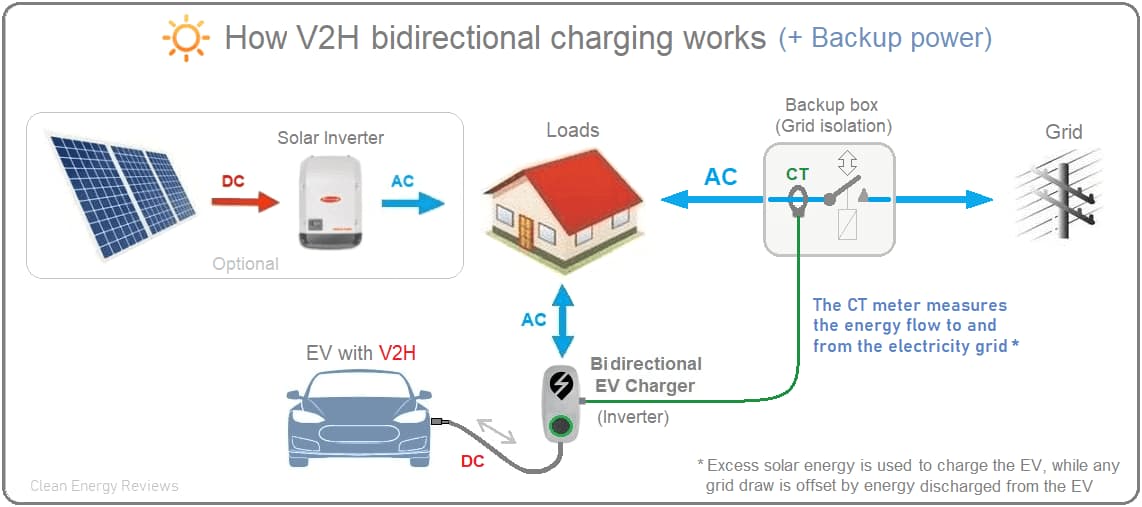
Exploring Bidirectional Charging: Empowering Electric Vehicles and Beyond
In the world of electric vehicles (EVs), bidirectional charging is an emerging technology that revolutionizes the way energy is utilized. Unlike traditional charging methods, where energy flows only from a power source to an EV battery, bidirectional charging allows EVs to share their stored energy with other devices, such as the grid, homes, loads, or even other vehicles. In this article, we delve into the concept of bidirectional charging, its functionality, different applications, and the vehicles that offer this cutting-edge capability.
Understanding Bidirectional Charging
Bidirectional charging involves converting alternating current (AC) power from the grid into direct current (DC) voltage, which is then stored in an EV's battery during the charging process. Subsequently, EV drivers can access this stored power to either supply electricity to their homes or contribute it back to the grid. This conversion from DC to AC electricity is facilitated by a converter integrated within the vehicle or the charger itself.
Types of Bidirectional Charging
Bidirectional charging encompasses various applications that cater to specific needs and equipment capabilities. Let's explore some of the prominent types:
Vehicle-To-Home (V2H)
With V2H technology, an electric car can serve as a power source for a home, particularly during power outages. Additionally, households that subscribe to time-of-use rates can take advantage of using the EV battery power during peak electric rates, subsequently recharging the vehicle when electricity rates are lower. To enable power transfer from an EV to a home, a power control system needs to be connected to the home's electrical distribution center, with the vehicle plugged into the charger to facilitate electricity flow.

Image Source: Clean Energy Reviews
Vehicle-To-Grid (V2G)
V2G involves EVs communicating with the utility grid and supplying power as required. Many experts believe that bidirectional charging will play a crucial role in future power grids and the widespread use of renewable energy. V2G capabilities allow EV batteries to be charged with renewable energy, such as solar and wind power when it's available. Subsequently, the EVs can supply power back to the grid when the batteries are not in use, thereby reducing greenhouse gas emissions.

Image Source: Clean Energy Reviews
Vehicle-To-Load (V2L)
EVs equipped with V2L capabilities feature a built-in DC to AC inverter and a standard power outlet. This configuration enables users to plug their devices or loads directly into the vehicle outlet, utilizing power directly from the EV battery. Vehicles like the Ford F150 Lightning, Rivian R1T, Hyundai Ioniq, Kia EV6, and Tesla Cybertruck offer V2L functionality, extending the utility of EVs in various scenarios, such as camping or when access to utility power is limited.

Image Source: Clean Energy Reviews
Vehicle-To-Vehicle (V2V)
To address range anxiety and enhance flexibility, some automakers are exploring V2V charging capabilities. This feature allows one EV to provide power to another EV, thereby extending its collective range. Currently, only the Ford F150 Lightning and Lucid Air offer this capability, but it presents an exciting potential for collaborative charging networks.
Benefits of Bidirectional Charging
Bidirectional charging offers several advantages that contribute to the overall appeal of EVs and their integration into the energy ecosystem:
Potential Utility Bill Savings
By leveraging bidirectional charging in conjunction with time-of-use rates, EV owners can strategically utilize electricity during off-peak hours, taking advantage of lower energy prices. This can result in significant savings on utility bills.
Backup Power During Blackouts
EVs equipped with V2H capabilities can serve as a reliable backup power source during utility outages. Depending on the battery capacity and charge level, an EV can power an entire home, offering a sense of security and resilience in times of blackouts.
Power Beyond the Grid
V2L functionality allows EVs to power specific loads by connecting them to the vehicle's outlet. This feature proves invaluable in situations where utility power is unavailable, such as camping trips or construction sites where tools can be powered directly from the EV.
Other Bidirectional Charging Resources:
Conclusion
Bidirectional charging is a groundbreaking technology that empowers EVs to play a more active role in the energy ecosystem. Although it is not yet widely available for most vehicles, bidirectional charging holds immense promise for the future of sustainable energy usage. By enabling V2H, V2G, V2L, and V2V capabilities, this technology opens up possibilities for cost savings, backup power solutions, and increased flexibility. As the EV industry continues to evolve, bidirectional charging will likely become a pivotal component in shaping a cleaner and more resilient energy landscape.
Got questions about solar power, battery storage, and bidirectional charging? Contact Got Watts to discuss your project and questions.
